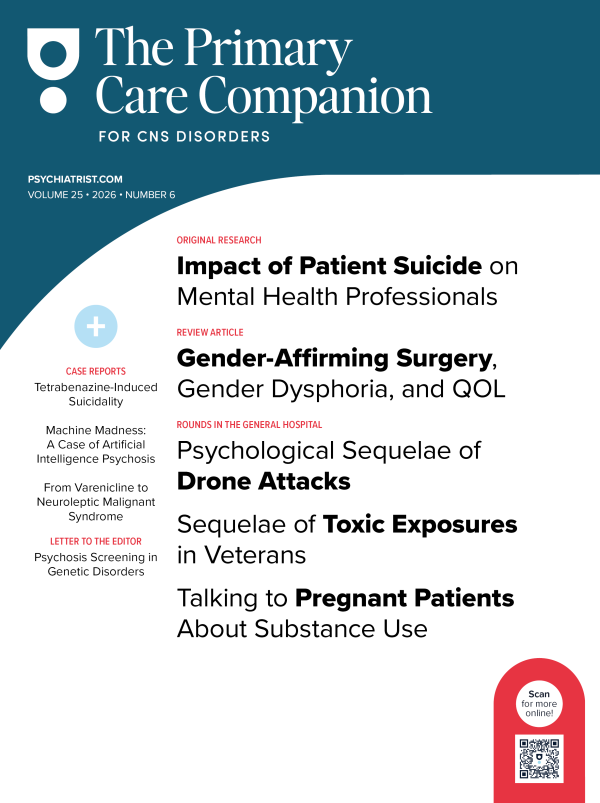A Case of Intention Tremor Induced by the Combination of Aripiprazole and Lamotrigine
To the Editor: In patients with chronic disabling psychiatric conditions in whom many therapeutic interventions have been implemented, augmentation and combination therapies are commonly used to improve the outcome. The number of visits during which a psychotropic medication was prescribed increased from 32.73 million to 45.64 million in less than 10 years in office-based physician practices in the United States.1 Here, we report a case of intention tremor induced by a combination of aripiprazole and lamotrigine.
Case report. Ms A was a 60-year-old white woman with a 6-year history of DSM-IV major depressive disorder and generalized anxiety disorder and no history of psychiatric hospitalizations. Her past medical and surgical history was significant for type 2 diabetes mellitus, above-knee amputation, hysterectomy, and arthritis. Her family history was negative for psychiatric disorders. She denied smoking, drinking alcohol, or using illegal drugs.
Multiple medications were tried before Ms A became stable on treatment with lamotrigine 300 mg/d for several years. Although the patient was stable, there was room for improvement in her symptoms, and in February 2011, aripiprazole 5 mg/d was added as an augmenting agent. The patient’s symptoms improved, and she became socially active, volunteering at the local hospital and spending time with her friends. However, 2 months after starting aripiprazole treatment, the patient developed a disabling intention tremor in her hands, head, and jaw. Lamotrigine was tapered off slowly with no deterioration of her mood and complete resolution of her tremor. Moreover, she reported maintaining an active social life at 3-, 6-, and 12-month follow-up.
Our patient was prescribed both lamotrigine and aripiprazole for major depression, and she had a therapeutic response, but we noted an interesting adverse effect that can be attributed only to the concomitant prescription of these medications.
Aripiprazole, like other atypical antipsychotics, displays antagonistic action at serotonin-2A (5-HT2A) receptors. However, it differs from other antipsychotics in that it is a partial agonist at dopamine-2 receptors and 5-HT1A receptors.2 Both cytochrome P450 (CYP) 3A4 and the polymorphic enzyme CYP2D6 are involved in the metabolism of aripiprazole to its main metabolite dehydroaripiprazole.3 On the other hand, lamotrigine is metabolized predominantly by glucuronic acid conjugation, mainly by UDP-glucuronosyltransferase 1A4 with the inactive 2-N-glucuronide conjugate as the major metabolite.4 Literature suggests that lamotrigine increases the concentration to dose ratios of aripiprazole by 51%.5
According to the Naranjo Adverse Drug Reactions Probability Scale, the intention tremor reaction reported in this case can be classified as a “probable” association between the combination of aripiprazole and lamotrigine and the side effect.6 The onset of the clinical adverse effect is consistent with the administration of the drugs together, and the effect was not present when either drug alone was given to the patient.
To our knowledge, this is the first report of a clinical interaction of aripiprazole and lamotrigine that resulted in intention tremor. We anticipate that many more such cases will surface as combination treatment becomes a norm in the treatment of psychiatric illnesses. Clinicians should be vigilant against this problem and should be ready to adjust treatment with discontinuation of either medication if faced with such an adverse effect in their patients.
References
1. Pincus HA, Tanielian TL, Marcus SC, et al. Prescribing trends in psychotropic medications: primary care, psychiatry, and other medical specialties. JAMA. 1998;279(7):526-531. PubMed doi:10.1001/jama.279.7.526
2. Davies MA, Sheffler DJ, Roth BL. Aripiprazole: a novel atypical antipsychotic drug with a uniquely robust pharmacology. CNS Drug Rev. 2004;10(4):317-336. PubMed doi:10.1111/j.1527-3458.2004.tb00030.x
3. Mauri MC, Volonteri LS, Colasanti A, et al. Clinical pharmacokinetics of atypical antipsychotics: a critical review of the relationship between plasma concentrations and clinical response. Clin Pharmacokinet. 2007;46(5):359-388. PubMed doi:10.2165/00003088-200746050-00001
4. Green MD, Bishop WP, Tephly TR. Expressed human UGT1.4 protein catalyzes the formation of quaternary ammonium-linked glucuronides. Drug Metab Dispos. 1995;23(3):299-302. PubMed
5. Castberg I, Spigset O. Effects of comedication on the serum levels of aripiprazole: evidence from a routine therapeutic drug monitoring service. Pharmacopsychiatry. 2007;40(3):107-110. PubMed
6. Horn JR, Hansten PD, Chan LN. Proposal for a new tool to evaluate drug interaction cases. Ann Pharmacother. 2007;41(4):674-680. PubMed doi:10.1345/aph.1H423
Author affiliations: Department of Psychiatry, Veterans Affairs Medical Center, Salem, Virginia (Drs Ali and Kim); and Carilion Clinic, Virginia Tech Carilion School of Medicine Psychiatry Residency Program, Roanoke (Drs Singh and Iskandar).
Potential conflicts of interest: None reported.
Funding/support: None reported.
Published online: January 19, 2012.
Prim Care Companion CNS Disord 2012;14(1):doi:10.4088/PCC.11l01236
© Copyright 2012 Physicians Postgraduate Press, Inc.





